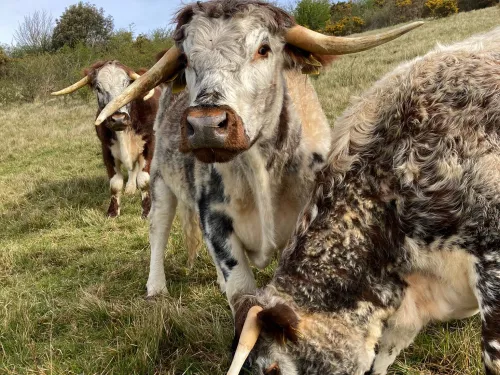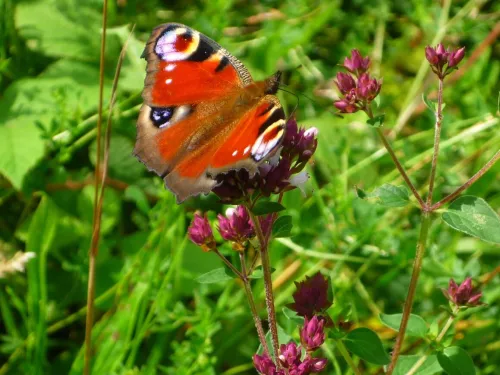
Wilder Kent Safari: Walking with Cows at Heather Corrie Vale
Meet some of the cattle who manage this reserve naturally, and learn all about them from our experienced Area Manager for the region.

Our White Faced Woodlands are our rarest breed of sheep and are also the largest out of the four breeds, with both ewes and rams being horned. As their name suggests, they are brilliant at grazing within woodland habitats and prefer browsing leaves and woody growth – great for controlling the encroachment of woodland edge habitat into grassland areas or diversifying a young chestnut coppice plantation for instance.
Hebridean sheep are the most used breed in conservation grazing and have a particular preference for browsing bramble and young tree saplings. They are fast and nimble, using their small stature to infiltrate dense scrub and break up vegetation clusters. Their colour allows them to hide in shadows easily too. Often, if we didn’t have a sign on the gate, people would never know they were on the nature reserve.
Herdwicks are very well adapted to rainy weather thanks to their oily, dense fleece which keeps them warm and dry in all weathers. Their fleece also acts as a brilliant camouflage tool in the hills of the Lake District, where they originate, disguising them as rocks to avoid predators. They have a distinct preference for thistles when grazing in the spring and summer rather than the really tough vegetation but they will take young woody regrowth too.
Manx sheep do well on rough grazing and is an active browser preferring stinging nettles. They use their horns to bash the nettles and remove the irritating pin-like hairs on the stem before eating them. The breed also retains its ability to self-shed its fleece by rubbing against branches, logs and tree trunks to help remove it’s thick felt-like wool. The most striking feature of these sheep is the presence of four horns, with some growing six.
When sheep are used in conjunction with other animals such as cows, ponies and pigs, the habitat becomes even more diverse. Whilst cows and ponies graze at different heights, rootling pigs turn over the soil and create a mosaic of grassy tussocks and micro habitats which will attract insects, birds, small mammals and much more.

Meet some of the cattle who manage this reserve naturally, and learn all about them from our experienced Area Manager for the region.

In Kent, our grazing animals roam the reserves using their instincts and experience to guide them towards delicious nutritious vegetation and away from potentially toxic plants. This deep-rooted wisdom is a product of evolution and survival instincts…

How do you restore a chalk downland? Our appeal to purchase an extension to our existing Polhill Bank nature reserve offers us a unique opportunity to restore an additional 26 acres of arable land into a rare and biodiverse habitat in Sevenoaks, Kent. But…